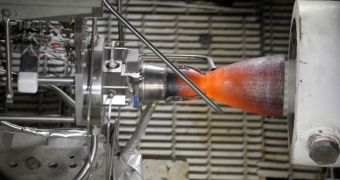Officials at the Boeing Company and Pratt and Whitney Rocketdyne announce the successful testing of a thruster designed to power the Crew Space Transportation (CST-100) space capsule that the former is building under a Commercial Crew Development (CCDev2) contract with NASA.
Boeing is just one company in a larger group of contractors working with the American space agency. Its competitors include Space Exploration Technologies Corporation (SpaceX) and Orbital Sciences Corporation (OSC).
CST-100 is being developed specifically for low-Earth orbit (LEO) applications. This is what enabled Boeing engineers to reduce the volume and weight of equipment necessary to support such missions, therefore allowing them to create an interior volume that can hold up to 7 astronauts.
The vehicle will have the ability to dock to the International Space Station (ISS), and deliver either supplies or replacement crews to the orbital lab. Lately, Boeing has been putting its vehicle through a number of assessments, including helicopter drop tests meant to assess its parachute system.
According to officials from the company, each CST-100 capsule will have a so-called orbital maneuvering and attitude control system (OMAC). A single OMAC will be made up of 24 thrusters and related components, and its role will be to ensure that the spacecraft can move in orbit.
But these motors also fulfill a security need. In case an error appears during launch or ascent, their job is to push the actual capsule away from the delivery system, in effect acting like a Launch Abort System.
“Boeing and Pratt and Whitney Rocketdyne know what it takes to develop safe systems and subsystems,” says the manager of the NASA Commercial Crew program, Ed Mango.
“They're building on the successes of their past, while pushing the envelope with next-generation ideas to create a spacecraft for low Earth orbit transportation,” the official goes on to explain.
The new motor tests took place in Las Cruces, New Mexico, at the NASA White Sands Test Facility. This installation was able to simulate the environment found at an altitude of 100,000 feet (30,500 meters). This provided data on how the thruster behaves under extreme heat.
“We're excited about the performance of the engine during the testing and confident the OMAC thrusters will affordably meet operational needs for safe, reliable human spaceflight,” comments the Manager of the Pratt and Whitney Rocketdyne Commercial Crew Development program, Terry Lorier.

 14 DAY TRIAL //
14 DAY TRIAL //